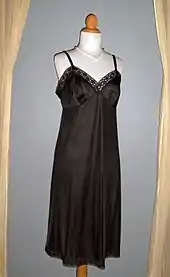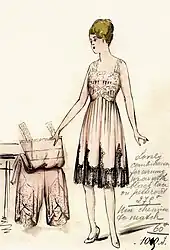Slip (clothing)
A slip is a woman's undergarment worn beneath a dress or skirt. A full slip hangs from the shoulders, usually by means of narrow straps, and extends from the breast to the fashionable skirt length. A half slip (or waist slip) hangs from the waist. The word petticoat may also be used for half slips.


Purposes
Slips serve various purposes. They help a dress or skirt hang properly, especially when static cling might otherwise cause the dress to wrap around the wearer's legs.[1] They protect the skin from chafing against coarse fabrics such as wool; conversely, if the outer garment is made of fine fabric, a slip protects it from perspiration. A slip may be worn for warmth, especially if the dress or skirt is lightweight and thin, whereas in very warm or humid climates, a slip made entirely from cotton may be desired. Slips are often worn to prevent the show-through of intimate undergarments such as panties or a brassiere. A slip may also be used to prevent a silhouette of the legs showing through clothing when standing in front of a bright light source.
Types

Slips fall into two major categories. A full slip hangs from the shoulders by straps that extend down to the top of the breast area, with a skirt below the bust. Full slips come in a variety of lengths; some extend down to the upper thigh, some to just above the knees, or just below the knees, while others go down to just above the ankles.
A waist slip, "half slip", or "underskirt", is held on to the body around the waist by means of an elastic waistband. The waist slip is also available in the same lengths as the aforementioned full slip. Waist slips that extend down to just above the ankle are often called formal slips, or maxi slips. Mini slips are yet another size option for waist slips. They were first introduced in the 1960s to wear under a mini skirt. American Maid manufactured waist slips that had vents and a rear zipper in addition to the elastic waistband. These slips were made of half nylon and half dacron polyester. As an alternative to the full slip, a waist slip with a matching camisole can be worn to provide full coverage.
There is also similar garment designed to be worn under thin or light-colored slacks, called trouserslips or pettipants. In addition to pants, a pettipant may also be worn under a dress or skirt, and like slips, they are mainly made of nylon or as a layer of luxury, in silk.
Decorations and fabric
Many slips have floral lace at the hem, vents or sideslits. Some of the older slips have decorations, such as a butterfly or flowers sewn into the fabric of the slip, and a pillowtab was also added to the waistband of a waist slip.
The vast majority of modern slips are made entirely of nylon, while others are made from polyester, rayon, acetate, silk or in some cases cotton. Still, there are others made of blends, and the label of the garment might read, for example, "40% nylon, 35% rayon, 25% polyester". Nylon slips are often shiny in appearance, and are very smooth to the touch, while polyester slips can even be more shiny with a real slippery feel, especially charmeuse or "satin" slips. Although charmeuse slips have very attractive eye appeal, they are not as durable as nylon slips, and often tear very easily, especially when wet.
Most of the slips made since the late 20th century are plain and lacking in detail. Intricate decorations and lace designs are almost completely absent from modern-day slips.
History

Slips made in the 1940s were mainly made entirely of rayon due to the war effort. In the late 1940s, some nylon slips began to appear on the market, and the vast majority of slips made in the 1950s were nylon. In the 1960s, slips were offered in a much greater variety of colours, including multi-coloured slips. Slips with a floral print design were also made available. Some of the most well known slip brand names of the past are: Lorraine, Dior, Velrose, Shadowline, Wondermaid, Warner's, Kayser, Maidenform and Van Raalte. There are well established slip/lingerie manufacturers still in operation today such as Vanity Fair, Vassarette and Sliperfection.
With the rise of athleisure and comfort dressing, slips were worn less, because they were unnecessary with the popular clothing.[1]
Although slips are primarily marketed as women's clothing, the technical gender-neutrality of the garment is such that men who wear unbifurcated lower-body apparel (as has been done historically across the world and contemporarily prevails still in many parts of the world) occasionally wear them. Men who choose to wear slips often wear black half-slips with minimal or no lace. Kilts often come with “kilt-liners,” which are essentially size-tailored half-slips.
Other usages
The word "slip" has come to refer to a number of other undergarments. In German, French, and Italian the word “slip“ is commonly used for panties. (This is a false friend, as is the use of "le smoking" to describe a tuxedo jacket.) "Slip" is also sometimes used for the brief style of men's underwear.[2] In the incontinence product market, the word "slip" is often used as a euphemism for an adult diaper or nappy, typically the "all-in-one" style that is worn by fastening on with adhesive tapes, similar to a larger version of the disposable ones worn by babies.[3]
Since the 1980s, dresses closely based on slips have become very popular.[4]
References
Notes
- Friedman, Vanessa (2021-02-05). "Hey, Whatever Happened to the Half-Slip?". The New York Times. ISSN 0362-4331. Retrieved 2021-02-07.
- "Clothing | F&F Clothing & Fashion | Tesco". Clothingattesco.com. Retrieved 2019-06-19.
- "Incontinence Slips". Allaboutincontinence. Retrieved 2019-06-19.
- Amy T. Peterson & Ann T. Kellogg, ed. (2008). The Greenwood Encyclopedia of Clothing Through American History 1900 to the Present. Westport, CT: Greenwood Press. p. 229. ISBN 9780313358555.
External links
 Media related to Slips at Wikimedia Commons
Media related to Slips at Wikimedia Commons